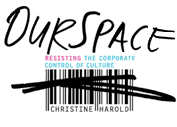INTRODUCTION

|
|
Reviewed by
Marshall Kitchens
Christine Harold opens her book, OurSpace: Resisting the Corporate
Control of Culture, by juxtaposing French philosopher Gilles Deleuze
with Adbusters co-founder Kalle Lasn: "Marketing is now the instrument of social control and produces
the arrogant breed who are our masters." -Deleuze "America is no longer a country. It’s a multitrillion-dollar
brand . . . America." -Lasn This juxtaposition of elite theory with proletarian activism is woven
throughout the book as a heuristic for examining the relationship between
corporate power and individual resistance within the body public at a time when
common folks are increasingly creating countercultural spaces in digital spheres. Inevitably,
some theorists argue, those spheres are co-opted by corporate power. Harold's use and critique of neo-Marxist theory coupled with her examination of the effectiveness of social activism is a fascinating overview of the weaknesses and strengths of the anti-corporate movement. At 190 pages (including notes and index), OurSpace is a brief but dense analysis of culture jamming in a world of Web 2.0. It is a provocative approach to digital and contemporary commercial culture that employs 26 graphic illustrations of détournement, parody, and other culture jamming practices to demonstrate attempts at resistance in action. Harold critiques a range of theorists from the neo-Marxists in the Frankfort school to the Situationists to Baudrillard, Fiske, and Deleuze in attempt to shift critique from the terminal resistance of détournement and sabotage (a kind of futile activism that calls for the rejection of market culture) to the generative augmentation of intensification (a form of activism that exploits the tools of the market for the common good). In other words, "Rather than saying 'no' to consumer culture as the antithesis of healthy, thriving publics, an intensification strategy says 'yes, and' to the tools markets afford" (xxix).
Harold ultimately proposes that the strategies of late capitalism be used to further causes of social justice that ultimately work in conflict with the capitalist machine. Where that struggle is ultimately going, however, is left unclear. To readers interested in exploring the ways that the tools of marketing can be used against the dominant discourse and for the common good, OurSpace offers a dense theoretical context for culture jamming in digital and physical spaces, as well as practical examples of turning branding on its head. The efficacy of these culture jamming practices, however, remains to be seen. A useful text in an advanced course in the critique of digital culture, OurSpace raises questions about the limitations and possibilities of resistance to corporate culture that can provide rich classroom debate about the relationships between the market and the individual within both digital space and meat space. Harold received her PhD in communication
at Pennsylvania State University, and her other publications include pop
culture critiques in Rhetoric and Public Affairs and Critical Studies
in Media Communication. In a speech at Harvard’s Berkman Center for Internet and Society, Christine
Harold describes herself as "neither a law person nor a tech
person, but trained as a rhetorician." An assistant professor in
the Department of Communication at the University of Washington, she puts
her rhetorical skill to use in this book. She is currently at work on a second book examining
the relationship between design, mass consumption, and environmental sustainability.
She describes OurSpace as emerging out of her work with interdisciplinary
cultural studies colleagues at Penn State and the University of Georgia,
a “result of ongoing jam session with a variety of talented friends
and scholars . . . many of whom contributed rich and textured ‘riffs’
to the ideas expressed in the pages that follow” (ix).